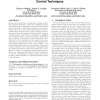Free Online Productivity Tools
i2Speak
i2Symbol
i2OCR
iTex2Img
iWeb2Print
iWeb2Shot
i2Type
iPdf2Split
iPdf2Merge
i2Bopomofo
i2Arabic
i2Style
i2Image
i2PDF
iLatex2Rtf
Sci2ools
ASSETS
2006
ACM
2006
ACM
The vocal joystick: : evaluation of voice-based cursor control techniques
Mouse control has become a crucial aspect of many modern day computer interactions. This poses a challenge for individuals with motor impairments or those whose use of hands are restricted due to situational constraints. We present a system called the Vocal Joystick which allows the user to continuously control the mouse cursor by varying vocal parameters such as vowel quality, loudness and pitch. A survey of existing cursor control methods is presented to highlight the key characteristics of the Vocal Joystick. Evaluations were conducted to characterize expert performance capability of the Vocal Joystick, and to compare novice user performance and preference for the Vocal Joystick and two other existing speech based cursor control methods. Our results show that Fitts’ law is a good predictor of the speedaccuracy tradeoff for the Vocal Joystick, and suggests that the optimal performance of the Vocal Joystick may be comparable to that of a conventional hand-operated joystick. Novice...
| Added | 13 Jun 2010 |
| Updated | 13 Jun 2010 |
| Type | Conference |
| Year | 2006 |
| Where | ASSETS |
| Authors | Susumu Harada, James A. Landay, Jonathan Malkin, Xiao Li, Jeff A. Bilmes |
Comments (0)

